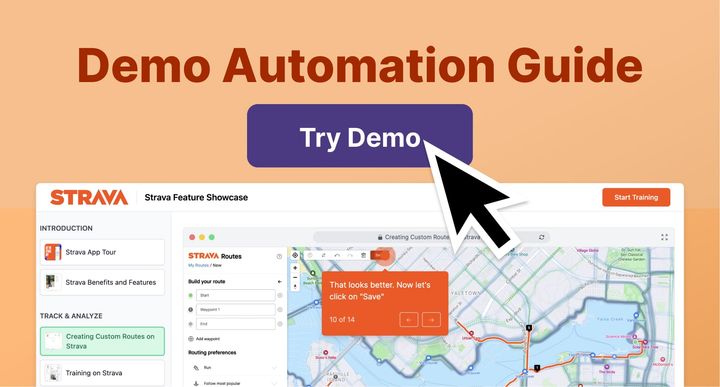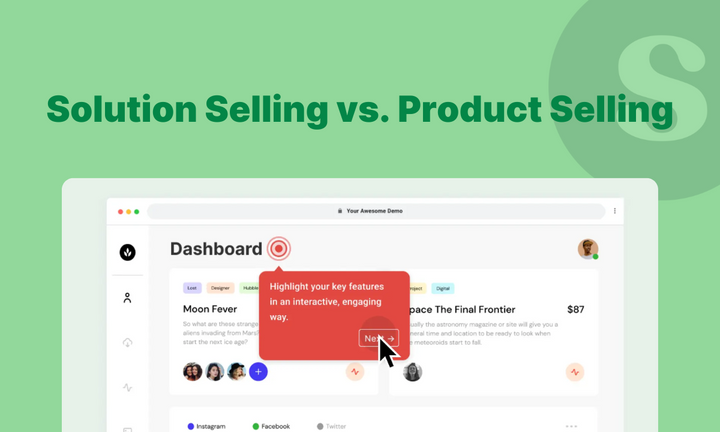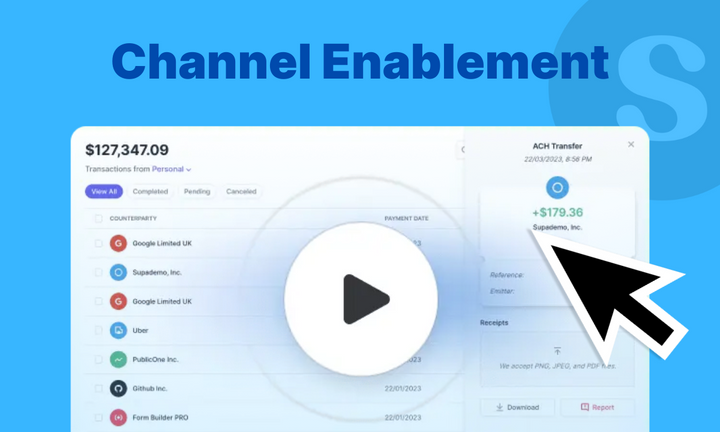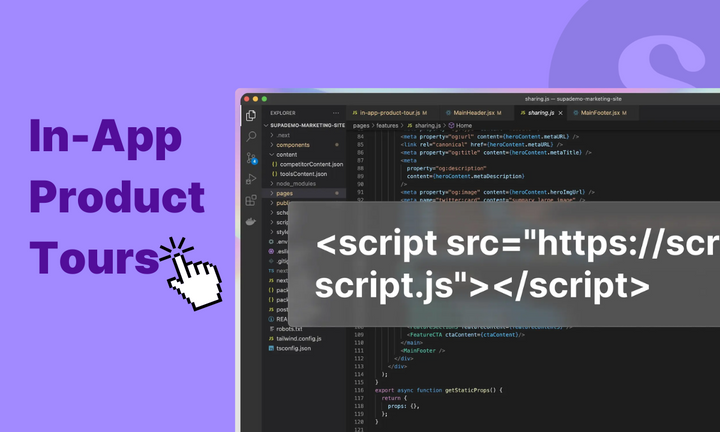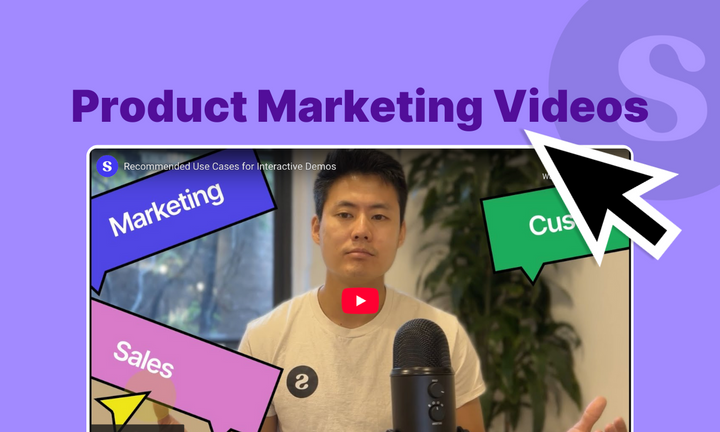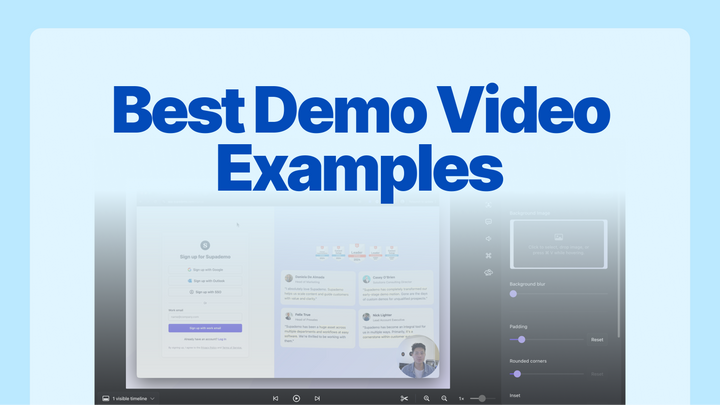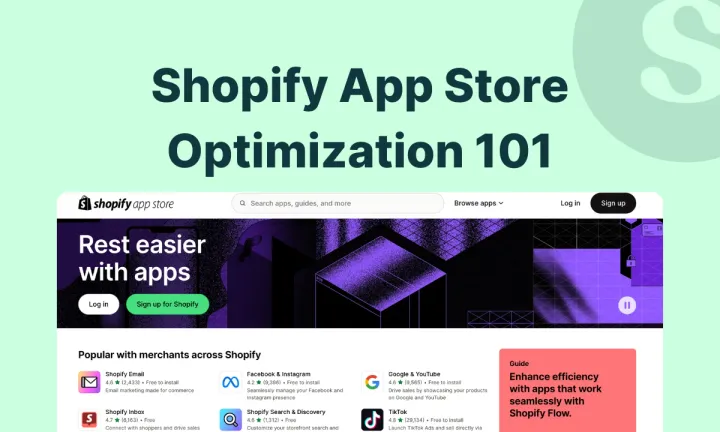Are you tired of the endless hours spent creating custom demos for every prospect?
With buyers becoming more educated and research-oriented, nagging them with a live sales demo isn’t going to close more deals. Also, with numerous stakeholders in the picture, you cannot rely on convincing a single person and hope to get buy-in without looping in other decision makers.
So what’s the solution? Enter demo automation – a multi-faceted strategy to elevate your demo process. Automated product demos can tailor presentations for diverse prospects based on their unique roles and needs. This approach can benefit not only sales but also marketing and customer success by demonstrating product value while streamlining the buyer's experience during the purchasing journey.
In this guide, we will share everything we at Supademo have learned about demo automation, and best practices to slash your demo creation time – freeing up valuable resources and boosting your revenue.
What is Demo Automation?
Demo automation is the process of using demo software or tools like interactive demos to automate the creation and delivery of product demonstrations. These product demo tools help you scale your demo production while allowing potential users to experience your product asynchronously, anytime, anywhere.

It’s common to mistake demo automation for traditional demo delivery methods, such as live sales demos or videos embedded on landing pages. But, there is a clear distinction.
Demo automation is a more advanced approach that leverages technology to streamline the process, while traditional methods rely on manual efforts. A demo library can further streamline the sales process by enabling sales representatives to access pre-made interactive demos containing reusable assets tailored for different verticals and use cases. This allows for efficient personalization and enhanced engagement with prospects.
What demo automation is not:
❌ a one-size-fits-all solution
❌ embedding a high-level video of your product’s features
❌ creating a library of custom product demos
❌ meant to replace the sales team or engineers
Demo automation extends beyond the traditional live demo process and reduces the time and effort to create and deliver product demos. This automated technology aids all departments of an organization, from marketing to engineering.
How Does Demo Automation Work?
Demo automation technology captures the front end of the software via screen recording or cloning. As you turn on a demo automation platform and navigate through your software, it captures pages or interactions (clicking, scrolling, typing, etc.) through screenshots and video or via HTML.
As a result, rather than relying on manually creating and updating demos, demo automation applications simplify the capturing, updating, and sharing process for software products.
These applications lead to better enablement by offering buyers an opportunity to explore features and benefits of the entire product or a particular workflow with little friction.
Demo automation is typically handled through a low-code/no-code environment, making it easier for creators (the person who builds the demo) to customize the recorded/captured demo to target specific prospects.
For instance, Supademo helps you add within each demo. These variables pull in particular information, such as the prospect's name, company, or role, to create a more personalized and engaging experience for the recipient:
Advantages of Using Demo Automation
As buyers start researching before booking a demo call with you, it’s crucial to ensure you can showcase how your product solves their pain points effectively. It means showing up early in the buying journey and visually guiding them through the benefits of your solutions visually, and not just with marketing jargon.
Demo automation allows for the creation of personalized demos that engage potential buyers more deeply, fostering stronger relationships through tailored content.
Demo automation visually illustrates your product’s features and benefits at every step of the buying journey:
1. Helps you deliver a consistent and engaging experience
More often than not, the way a demo is delivered may vary based on the person giving it, leading to an inconsistent customer experience. ~ Will Yang, Head of Growth & Marketing, Instrumentl
Automated demos solve the challenges of inconsistent and un-engaging sales demos. Through automation, you have the freedom to create hundreds of on-brand demos, personalized for each persona, use case, or product line. You can standardize the demo creation process by using a set template while personalizing the tone, screen captures, and CTAs.
Demo videos can be used to create interactive and analytical content, aiding in sales cycles and customer onboarding.

Instead of non-standardized or non-uniform demos, you can build a flawless demo experience that makes prospects remember you after the demo.
A demo built using demo automation software combines three learning methods:
- visual (compelling graphics and interface),
- tactile (clicking on hotspots to navigate each step), and
- sensory (use of voice-overs) learning.
The multi-sense, two-way learning model helps people retain information better since humans are naturally inclined to learn with more than one sense. Thus, these demos are influential in qualifying prospects early in the buyer’s journey.
2. Helps you reach and influence multiple stakeholders
The larger the business, the more stakeholders will be involved in decision-making. According to Gartner's 2024 Global Software Buying Trends, on average, five individuals are typically involved in researching, evaluating, and choosing new software.
Demo automation can be critical to creating great sales collaterals and looping in decision makers, helping your champions sell your product internally – without relying on them to understand pitch your product with the right words and lingo.

Instead, a step-by-step interactive guide is a foolproof way to showcase your product and benefit everyone involved in the buying process without them having to book a separate demo, watch a lengthy video, or read documentation.
3. Helps you retain customers and upsell
Customer retention is the secret sauce to the success of any SaaS business. And with 61% of B2B buyers being open to upgrading their plan within a few months, it's crucial to have scalable processes set up to increase the chances of upselling.
Demo automation can be embedded throughout enablement materials, onboarding, or feature pages to help reach customers at the right time or at their moment of inspiration – helping drive adoption, retention, and brand loyalty.
Similarly, marketing and product teams can leverage demo automation to send targeted emails, validate ideas, collect feedback, and analyze behaviour to better position their upsell messaging.
4. Helps you close more deals
One key benefit of demo automation is the flexibility to personalize each demo: either via a custom demo link or by adding dynamic variables. A personalized product demonstration increases conversions, as, during the research phase, this is the second most valued factor by B2B buyers, preceded by customer reviews.
Automated demos can significantly reduce the duration of sales cycles by providing prospects with immediate access to product demonstrations.
And in our product-led, self-serve era, buyers are increasingly doing their own research via customer feedback, competitor analysis, and peer review. This means they’re unlikely to book a demo or schedule a discovery call without doing some levels of due diligence. Demo automation allows buyers to do just this – where they can explore the product in a frictionless, self-serve way.

In fact, most buyers prefer a self-service experience where they get to be the narrator, figuring out how the tool fits in their JTD (jobs-to-be-done) framework before committing to a subscription.
The Role of Demo Automation in the SaaS Sales Cycle
Often, sales reps and demos go hand in hand, which makes sense given that the sales team is responsible for delivering the demo to potential customers.
After working with thousands of early-stage startups and interviewing product managers, sales development reps, and customer success managers, it’s clear that demo automation isn’t limited to just sales organizations.
The presales team plays a crucial role in addressing technical questions and providing valuable insights during live demos, ensuring well-qualified prospects receive the deeper engagement they seek before making a purchase decision.
In fact, demo automation is a powerful tool for any type of knowledge worker, whether it’s the marketing team who wants to generate more leads or onboarding managers who wish to scale visual guidance for their customers.
Where to Use Automated Demos in the Sales Process
Discovery Phase
Discovery isn’t just about sales teams gathering information—it’s also when prospects are looking to learn more about your product. Automated demos offer a convenient way for potential customers to explore your product's key features at their own pace, without needing to speak to a sales rep.
By placing these demos on your website, you give prospects the chance to engage with your product and see its value firsthand, helping them move through their decision-making process more independently.
Qualification Phase
Qualifying leads can be a time-consuming process for sales teams. Automated demos help speed this up by allowing prospects to assess your product without the need for a direct conversation.
Prospects who realize that your solution isn’t the right fit can easily disqualify themselves, saving both their time and yours. While this might seem like you're losing potential customers, it actually helps you focus on higher-quality leads—those more likely to convert into paying customers.
Middle of the Funnel
As prospects move further down the sales funnel, there's no need for your SEs (Sales Engineers) to jump in right away.
Using Supademo’s demo automation software, SEs can create reusable demos based on different industries or use cases. Sales reps can then send these customized, interactive demos to prospects.
This not only keeps the sales process moving but also sparks deeper questions, making sales calls more productive and focused on specific customer needs.
Post-Call Follow-Up
After an initial meeting with a prospect, your AEs (Account Executives) can send a follow-up email with a tailored automated demo that reflects the key points discussed.
This helps maintain the momentum, keeps your solution top-of-mind, and can move the conversation towards closing the deal.
Champion Enablement
Automated demos are also useful when enabling champions within a company. These champions—people who advocate for your product internally—can easily share an interactive demo with other decision-makers, eliminating the need for multiple meetings.
A personalized demo that addresses key pain points can go a long way in getting buy-in from the rest of the buying committee.
Here are some popular use cases of demo automation for various departments:
Live Demo vs. Automated Demo: What's The Difference
Demos are essential for various business processes, including sales, marketing, onboarding, customer success, and product management. Demonstrating how your product can solve specific problems boosts your chances of achieving your goals. Automated demos can streamline the sales process by allowing sales teams to focus on high-quality leads.
But should you opt for an automated demo or a live demo?
As discussed above, the benefits and use cases of demo automation are multi-fold - from ease of use to better deal closures with minimal effort.
When to Use Live Demos
While automated demos should be your go-to for most scenarios, there are instances where live demos are irreplaceable:
- High-Value Sales: For high-value prospects nearing a purchase decision, live demos offer a personalized touch that can address specific queries and objections in real time.
- Complex Onboarding: For clients with complex needs or those requiring detailed customization, live demos can provide the tailored assistance necessary to ensure a successful onboarding experience.
- In-Depth Training: For high-value clients or complex use cases, live demos offer an interactive platform for in-depth training sessions, ensuring comprehensive understanding and satisfaction.
A Balanced Approach
To maximize effectiveness, consider a balanced approach:
- Start with Automated Demos: Use automated demos for initial engagement, lead qualification, and educating multiple stakeholders.
- Transition to Live Demos: Once prospects are qualified or specific issues need to be addressed, switch to live demos for a more personalized experience.
Demo Automation in Action: Real-life Examples

1. Interactive demos in help docs
Owned by: Customer success or product team
You spend hours drafting your help docs — outlining each step, figuring out the best screenshot format, and customizing the format to fit your brand's guidelines. It's a heck of a lot of work. Imagine if, three months down the line, there is a minor but significant change in the UI, and you need to repeat these steps all over again.
You probably have been doing it way longer than you realize, but there's an easy and (fun) way to improve the process. Build interactive demos for support and knowledge docs and empower users to learn by doing.
It helps in the following ways:
✅ No need to take screenshots or time-consuming video as interactive demo applications record each interaction as you move from one step to another, saving you tons of time.
✅ No need to change the entire demo with a significant UI change. You can easily add or remove any step while keeping the rest of the demo intact.
Porter Metrics, a cross-channel market reporting platform, has transformed its help guide into an interactive demo experience, making users learn by doing rather than reading. This has helped them cut their customer success team by 50%

2. Asynchronous interactive onboarding
Owned by: Customer success or the onboarding team
Instead of getting on live onboarding calls with new customers and repeating yourself, demo automation helps you build a scalable and standardized onboarding experience. With demo automation, customers aren't expected to remember every feature or workflow – they can access this anytime, anywhere – as a link or as an embedded resource in training and help docs.
You can build a series of "choose your own adventure" branching demos, or compile multiple demos into a single, shareable showcase collection. These showcases can be used as templates based on company size, persona, use case, or products adopted.
Here’s what an interactive demo onboarding kit looks like:
3. Personalized outreach and prospecting at scale
Owned by: Marketing or sales team
What's an effective automation if it's not personalized, right?
No matter whether you want to automate demos for sales outreach or marketing campaigns, you can add a personal touch to all your demo content through dynamic variables.

For instance, in Supademo, you can personalize the following elements to add a level of personalization and customization at scale:
- Hotspot texts
- Shareable demo link
- Title and subheading of demos
This helps increase open rates, clicks, and responses – leading to more qualified prospects and more deals closed.
Here’s an example of adding your prospect’s name and the company they work for in each demo.
How to Evaluate Demo Automation Software
While demo automation technology is still in its infancy, it’s a popular category with increasing interest from new and existing players. Selecting the best demo automation software is crucial to enhancing demo processes and achieving better sales outcomes.
If you’re considering adopting demo automation as part of your workflow, here are some must-have attributes:
Ease of use
This is an absolute must. Demo automation only saves you time if the platform itself is user-friendly, easy-to-use, and has a low learning curve. You are not saving time if you spend more time building complex workflows, struggling with complex technical details, or surfing hundreds of resources to navigate the platform effectively.

At Supademo, ease-of-use has been a huge priority – where our goal is to offer a self-explanatory, product-led experience where anyone can start creating beautiful interactive demos, regardless of technical competency.
Our investment in ease-of-use can be seen through G2, where Supademo ranked as the leader in ease of use and time-to-launch.
AI-powered functionality
Generative AI helps in all areas of demo automation – personalization, creating/scaling content, and internationalizing it to different regions and languages.
Supademo AI incorporates three different AI-powered features to simplify the creation, maintenance, and deliverability of product demos to customers:
- Synthetic AI Voiceovers: Choose from an array of human-like voiceovers to automatically narrate your demos without manual recording and edits;
- Generative AI Text: Automatically write text prompts for each demo step, based on the provided prompt and the sequence of HTML elements clicked in your recording;
- AI Translate: Internationalize demos to different languages in one click;

With the growing acceptance of generative AI, AI functionality should be a key consideration when evaluating different types of interactive demo platforms.
Building and editing demos
Put a great emphasis on the kind of demos you want to build and then compare them against the tech offered by different vendors. Self-paced guided demos are often synonymous with demo automation technology as they're easy to build, customize, and share.
If you're considering creating just a few demos, you may want to consider HTML-based interactive demos. But if you're looking to create and scale demo content across multiple use cases, you may want to leverage demo platforms that focus on screen recording.

In addition to this, ensure the demo editing experience is simple and intuitive. Leading demo automation platforms should support functionality like:
- Personalization, such as dynamic variables and custom demo links to tailor each demo to the prospect's pain points.
- Zoom and pan make your demos 10x more engaging and fun. It helps you eliminate the monotonous slides and emphasize specific actions, options, or features.
- Swap out slides easily to maintain demos as features or designs change – without having to create the demo again.
- Built-in blur and annotation features to easily hide sensitive information without having to leverage a separate app or resource.
Lead generation capabilities
Consider how the platform supports your lead generation efforts. Ideally, demo automation platforms should offer the feature of embedding lead generation form or feedback forms within the demo (after ascertaining slides have passed or towards the end of the demo).

Also, see if the platform helps you make specific gated demos – whether it's password-protecting to specific clients, or gated with an email capture step. Supademo is one platform that allows you to automate your gated demo process through a library of templates and dynamic variables.
How Supademo Helps Automate Your Demo Process
Supademo is a fast-growing demo automation software recognized as a leader by G2 in this category. The platform helps create and share interactive demos through an easy-to-use, no-code demo builder.
Through Supademo's Chrome extension, you can walk through any product or workflow and magically transform it into a step-by-step, interactive demo. This can then be shared across onboarding, support docs, or in sales and enablement to accelerate time-to-value and adoption.
Key features include:
- AI features: It helps you rewrite hotspot texts, generate voiceover, and translate voiceovers and text steps in multiple languages;
- Demo Showcases: group multiple, related Supademos into a single URL link or embed with demo showcases
- Dynamic variables: Adding dynamic variables lets you personalize each interactive demo for better targeting and higher relevancy.
Here’s an example of an interactive product demo in action:
Get Started With Demo Automation
Demo automation shows enormous potential and will likely become integral to businesses' efforts across the entire customer journey. By allowing users to learn about different features and experience the Aha! Moment, you can reduce both friction and manual work for multiple departments.
Many early-stage startups and mid-size businesses have seen tremendous benefits after deploying demo automation across their organization — marketing to customer success.

For instance, ProcessMaker, an enterprise-grade business process and workflow automation platform, uses demo automation throughout its sales cycle, from initiating conversations to answering FAQs during live demos.
These success stories underscore the growth businesses can realize by automating the demo process. To get you started, Supademo offers a free plan with which you can create up to 5 demos and share them with your team.


